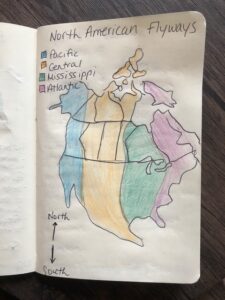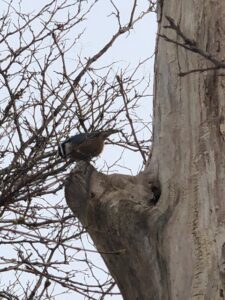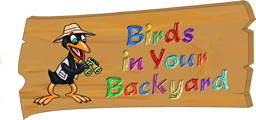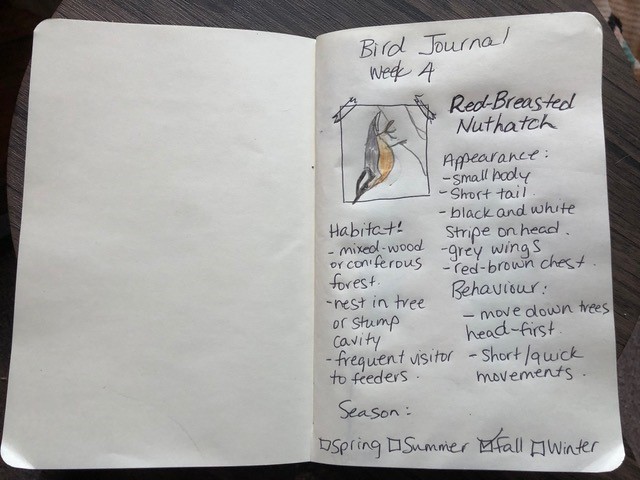Hello everyone and welcome back to the blog. The weather is changing, and we had our first
big snowfall this week. I had a new visitor to my feeder and enjoyed watching the birds explore
my homemade feeder from last week.

Over the past couple weeks I have been thinking about bird migration. It gets so cold and snowy
during Canadian winters that some birds choose to move to warmer climates during the winter
months. They do this in order to access new and more habitable climates as well as more
plentiful food supplies. While migration is common in many species of birds, there are those
who stay all winter and develop clever ways to feed themselves and stay warm and safe in the
cold. Some of the birds we notice in spring, summer, fall and winter are in different stages of
their migratory process, either moving northward or southward to suit their complex needs.
This means that some backyard visitors are only in the area for a short period of time, to nest,
eat, or rest from their long journey. This process of migration in North America has been
studied by scientists in different ways to determine how and why birds move the way they do.
The route that birds use during their migration is called a flyway. The flyway is a vertical
corridor used by birds in their journey north or south. I live in Ontario which means that the
migrating birds I see are part of the Mississippi Flyway. It goes from the Hudson Bay all the way
down to the American states of Mississippi, Alabama and parts of Florida. These states have a
warm climate during the winter months and make suitable habitats for the birds who can’t
withstand harsh winters. There are four main flyways in North America: Pacific, Central,
Mississippi, and Atlantic. Check out the map below to see which flyway you live in.
One of the most common sights to see in the fall as birds begin migration are the big V-shapes
in the sky, a flying formation used by geese, swans, ducks, and more. You might hear Canada
Geese honking loudly together and look up to see the magnificent V shape in the sky. The
honking sound is the birds communicating with one another so that they can stick together. The
V formation is a very cool system that birds use to keep their strength over long periods of
flying. It takes a lot of energy to fly all the way south, so birds have developed this system to
maximize their efficiency. They also take turns as the leader of the V.
Other smaller songbirds like warblers, starlings and thrushes migrate at nighttime when the air
is cool and calm. Insects who are also out at night provide some food as well. These birds tend
to move in flocks similar to the way the pigeons from last week coordinated their movements
and stayed together.

This week at my feeder I had an interesting visitor. At first glance it looked similar to a
chickadee, but upon closer observation I saw that it was much different. With a slender profile
and a distinctive white stripe on its head, I was able to determine that it was a Red-breasted
Nuthatch. It moved very quickly, taking a seed and then flying away immediately, it hopped in
the trees and pecked for insects on the tree bark. Something unusual I noticed was that it
moved down the tree head-first; in fact nuthatches are adapted for this head-first movement
which gives them a unique upside-down perspective when finding food compared to other
foraging birds. Their short tail helps them with this as well as their large back toe. The Redbreasted Nuthatch is often seen at feeders during the fall and winter, when its usual diet of
insects and seeds from trees begin to dwindle. Unlike the migratory species we have been
talking about, the nuthatch stays year-round.
I hope you enjoyed learning about bird migration with me and were able to add information
about your flyway to your Bird Journal. Keep an eye out for a Red-breasted Nuthatch in your
backyard. Maybe it will even visit your homemade feeder as the snow begins to fall.
Happy birding!

